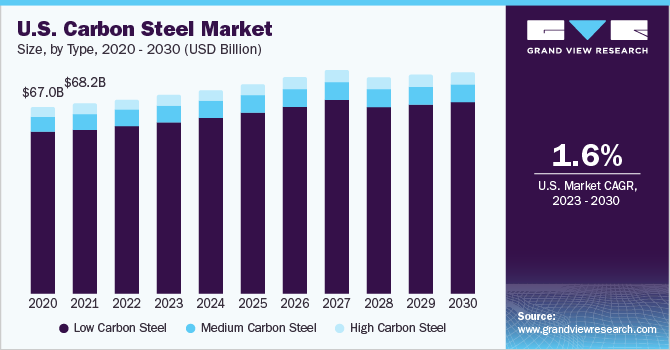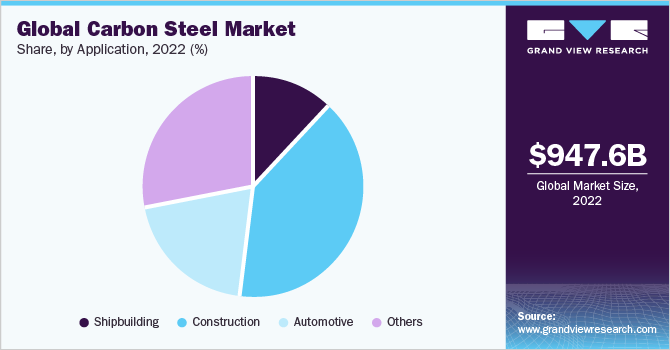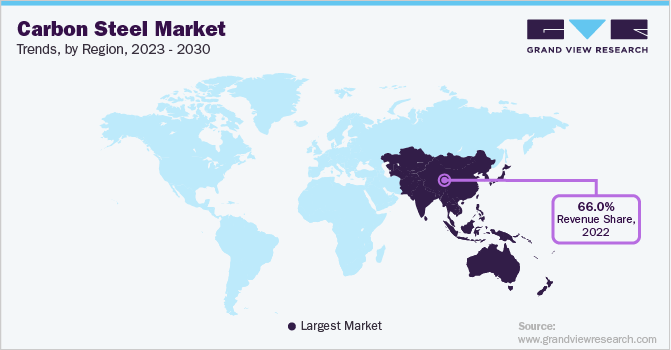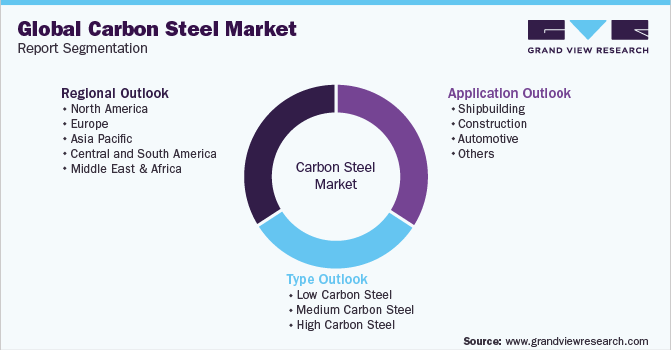- Home
- »
- Advanced Interior Materials
- »
-
Carbon Steel Market Share & Growth Analysis Report, 2023GVR Report cover
![Carbon Steel Market Size, Share & Trends Report]()
Carbon Steel Market Size, Share & Trends Analysis Report, By Type (Low Carbon Steel, Medium Carbon Steel, High Carbon Steel), By Application (Shipbuilding, Automotive, Construction), By Region, And Segment Forecasts, 2023 - 2030
- Report ID: GVR-4-68038-415-4
- Number of Report Pages: 108
- Format: PDF, Horizon Databook
- Historical Range: 2018 - 2021
- Forecast Period: 2023 - 2030
- Industry: Advanced Materials
Report Overview
The global carbon steel market size was valued at USD 947.60 billion in 2022 and is anticipated to grow at a compound annual growth rate (CAGR) of 4.0% from 2023 to 2030. Increasing focus on infrastructure development particularly in Asia Pacific countries is projected to drive the consumption of carbon steel products over the coming years. The Asia Pacific is likely to attract nearly 50% of infrastructure investment over the coming years. Countries such as India, China, and Southeast Asian countries are spending higher portion of their budget on infrastructure development to boost the overall economic growth. Carbon steel finds numerous applications in infrastructure, wherein it is used in frame materials, pipelines, fencing, gates, and variety of structural sections.

In terms of revenue, U.S. accounted for a market share of 7.3% in the global carbon steel industry. In U.S., the market is likely to be driven by a consistent increase in construction spending and moderate growth in the automotive sector over the coming years. As per the statistics provided by the U.S. Census Bureau, the annual value of the construction put in place has consistently increased in the last eight years. It has reached USD 1,798.09 billion in 2022 from USD 1,140.16 billion in 2015.
The U.S. non-residential sector accounted for 49.3% in total construction value of 2022 and is likely to play key role in rising demand for carbon steel products. The growth of non-residential sector is projected to be driven by government investment to replace the old infrastructure such as bridges, construction structures, and other transportation infrastructure.
The automotive sector in the U.S. has witnessed sluggish growth in the recent years. For instance, registration of vehicles in the country observed a decline of 1.5% in 2022 from 2021. However, the automotive sector in the country has achieved sales of over 10 million unit, with y-o-y increase of 10% in 2022. Carbon steel products such as gears, ratchets, shafts, and transmission parts are anticipated to witness incessant demand on account of positive long-term outlook of the automotive sector.
Type Insights
In terms of volume, the low carbon steel accounted for a market share of 90.8% in 2022. Based on type, the market has been categorized into low, medium, and high carbon steel. Low carbon steel is by far the largest segment and has observed the highest penetration in various end-use industries. Low carbon steel contains carbon content below 0.25 percent by weight. It is also referred as mild steel and can be used to create various shapes ranging from structural beams to flat sheets. It possesses versatile properties such as ductility, malleability, and cold forming abilities. It is available at a low cost compared to its counterparts.
Medium carbon steel contains higher carbon and manganese contents than low carbon steel, which makes it stronger but difficult to be shaped. Considering its characteristics such as high strength and good weldability, it is preferred in the production of machine and car parts. Thus, the segment is likely to witness CAGR of 3.0% in terms of revenue.
Application Insights
The construction industry held the largest volume share of nearly 42.0% in 2022 and this trend is anticipated to continue over the forecast period. Low carbon steel offers excellent forming and welding capabilities along with advantages such as no cracks on bending, flexibility, ductility, plasticity, and endurance in case of calamities like earthquakes, which make it a preferable choice in the construction industry. Carbon steel’s strength in calamity situations is its major benefit, which prevents the building from collapsing and saving its occupants.
Carbon steel finds application in shipbuilding, construction, automotive, and other applications such as energy, machinery, appliances, and material handling. The usage of steel in shipbuilding is owing to its mechanical properties and low cost. Carbon steel is of vital importance in the ship-building industry, however, the decline in industry growth along with the preference towards substitutes such as aluminum alloys is anticipated to hinder product consumption in the shipbuilding sector over the forecast period.

Automotive is projected to grow at the rate of 3.9%, in terms of revenue, from 2023 to 2030. Ductility and forming abilities of low carbon steel make it applicable in making the body structure and trunk closures of vehicles along with wear resistant gears. Medium carbon steel is used in the automotive industry as well as it offers higher strength and durability than low carbon, with little ductile properties. Growing emphasis towards lightweight vehicles is expected to propel carbon steel consumption in the automotive industry.
Regional Insights
In terms of revenue, Asia Pacific held the highest market share of over 66.0% in 2022 and likely to observe a lucrative growth rate during the forecast period. Expansion of shipbuilding in the recent years coupled with high industrial output from construction and automotive sectors are likely to contribute in the rising demand for the product.
The shipbuilding industry in Southeast Asia and China has witnessed growing demand in several past years. The industry has performed well after economic crisis in 2008. For instance, Philippines has been gradually growing as one of the leading shipbuilding centers since 2010 and has become the industry’s fourth largest shipbuilding hub in the world.

In terms of revenue, North America is likely to attain a CAGR of 3.1% from 2023 to 2030. In recent past, the demand for carbon steel in the U.S. benefitted from strong economic growth, which was driven by the government-led fiscal stimulus, leading to high business confidence. This led to high construction spending in the region. According to the statistics of the U.S. Census Bureau, the value of total construction put in place in U.S. increased by 10.6% in 2022 from 2021.
Key Companies & Market Share Insights
The market is slightly leaning towards consolidation. Recently, the industry has witnessed several mergers and acquisitions at a local level. For instance, in August 2022, Arcelor-Nippon Steel India announced acquisition of some infrastructure assets including electricity transmission lines and 2 power plants from Essar Group. This will ensure consistent seamless movement of finished goods and raw materials for Arcelor- Nippon Steel India. Some prominent players in the global carbon steel market include:
-
AK Steel Corporation
-
ArcelorMittal
-
Baosteel Group
-
Evraz plc
-
HBIS Group
-
JFE Steel Corporation
-
Nippon Steel Corporation
-
NLMK
-
POSCO
-
United States Steel
Carbon Steel Market Report Scope
Report Attribute
Details
Market size value in 2023
USD 980.32 billion
Revenue forecast in 2030
USD 1,301.53 billion
Growth rate
CAGR of 4.0% from 2023 to 2030
Market size volume in 2023
1,769.20 million tons
Volume forecast in 2030
2,243.52 million tons
Growth rate
CAGR of 3.3% from 2023 to 2030
Base year for estimation
2022
Historical data
2018 - 2021
Forecast period
2023 - 2030
Quantitative Units
Volume in kilotons, revenue in USD million, and CAGR from 2023 to 2030
Report coverage
Volume forecast, revenue forecast, competitive landscape, growth factors, and trends
Segments covered
Type, application, region
Regional scope
North America; Europe; Asia Pacific; Central & South America; Middle East & Africa
Country scope
U.S.; Canada; Mexico; Germany; U.K.; Russia; China; India; Japan; Brazil
Key companies profiled
HBIS Group; Baosteel Group; ArcelorMittal; Nippon Steel Corporation; POSCO; AK Steel Corporation; NLMK; Evraz plc; United States Steel; and JFE Steel Corporation.
Customization scope
Free report customization (equivalent up to 8 analysts working days) with purchase. Addition or alteration to country, regional & segment scope.
Pricing and purchase options
Avail customized purchase options to meet your exact research needs. Explore purchase options
Global Carbon Steel Market Report Segmentation
This report forecasts revenue and volume growth at global, regional and country levels and provides an analysis of the latest industry trends in each of the sub-segments from 2018 to 2030. For the purpose of this study, Grand View Research has segmented the global carbon steel market report on the basis of type, application, and region:

-
Type Outlook (Volume, Kilotons; Revenue, USD Million, 2018 - 2030)
-
Low Carbon Steel
-
Medium Carbon Steel
-
High Carbon Steel
-
-
Application Outlook (Volume, Kilotons; Revenue, USD Million, 2018 - 2030)
-
Shipbuilding
-
Construction
-
Automotive
-
Others
-
-
Regional Outlook (Volume, Kilotons; Revenue, USD Million, 2018 - 2030)
-
North America
-
U.S.
-
Canada
-
Mexico
-
-
Europe
-
Germany
-
U.K.
-
Russia
-
-
Asia Pacific
-
China
-
Japan
-
India
-
-
Central and South America
-
Brazil
-
-
Middle East & Africa
-
Frequently Asked Questions About This Report
b. The global carbon steel market size was estimated at USD 947.60 billion in 2022 and is expected to reach USD 980.32 billion in 2023.
b. The global carbon steel market is expected to grow at a compound annual growth rate of 4.0% from 2023 to 2033 to reach USD 1,301.53 billion by 2030.
b. Low carbon steel segment dominated the market with a revenue share of over 89.0% in 2022. The segment is witnessing significant growth owing to easy availability of material and low cost associated with it.
b. Some key players operating in the carbon steel market include HBIS Group, Baosteel Group, ArcelorMittal, Nippon Steel Corporation, POSCO, AK Steel Corporation, NLMK, Evraz plc, United States Steel, and JFE Steel Corporation.
b. Key factors that are driving the carbon steel market growth include increasing focus on infrastructure development particularly in the Asia Pacific as it is used in numerous applications in infrastructure, wherein it is used in frame materials, pipelines, fencing, gates, and a variety of structural sections.
Share this report with your colleague or friend.
![gvr icn]()
NEED A CUSTOM REPORT?
We can customize every report - free of charge - including purchasing stand-alone sections or country-level reports, as well as offer affordable discounts for start-ups & universities. Contact us now
![Certified Icon]()
We are GDPR and CCPA compliant! Your transaction & personal information is safe and secure. For more details, please read our privacy policy.
We are committed towards customer satisfaction, and quality service.
"The quality of research they have done for us has been excellent."





